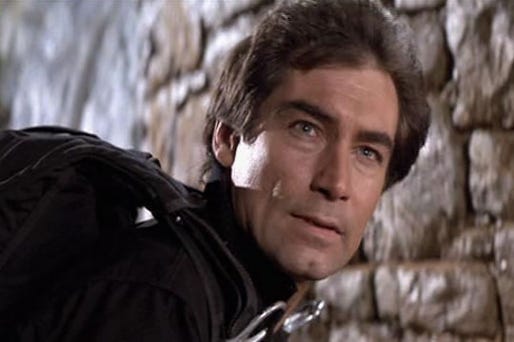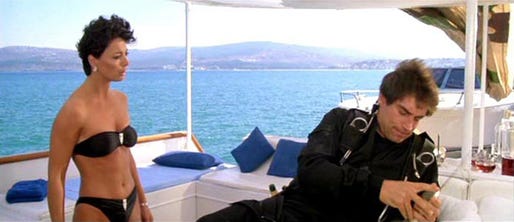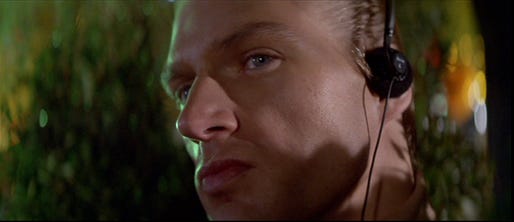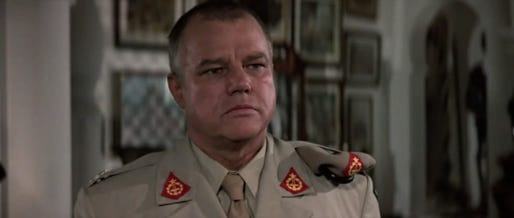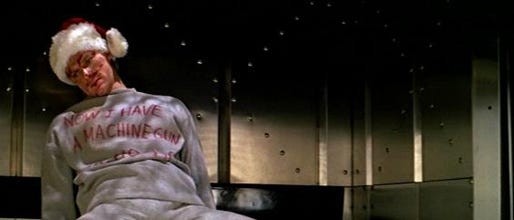You Only Live Twenty-Thrice: "The Living Daylights"
“You Only Live Twenty-Thrice” is a look back at the James Bond films.
Each Friday until the release of the 23rd official Bond film, “Skyfall,” we will revisit its 22 official predecessors from start to finish, with a bonus post for the unofficial films in which James Bond also appears.
Impudence. Impetuousness. Impulsiveness. A wit as dry as his martini. A ragged heart that craves a woman’s affection. A rigid mind that insists she’s just another asset. A rage that seethes. An ease at training guns on innocents. A soul that ultimately seems soothed only by savagery.
In 2006, this depiction of James Bond earned hosannas, nominations, best-ever back pats from two previous Bonds and the largest gross ever for a 007 film. In 1987, shades of the same thing earned barely more than “A View to a Kill” and an eventual dead-last spot (behind even George Lazenby) in a 2012 best Bond poll.
Admittedly, Timothy Dalton benefited neither from Daniel Craig’s seeming effortlessness nor an action-movie audience yet willing to cheer a grittier hero. But at least Dalton and company grasped at the idea of Bond’s internal tumult long before 007’s 21st-century reboot.
Coming hot on the heels of the departure of Roger Moore, who was always more comfortable with full quips than full clips, it felt especially radical. Back then, Dalton’s coiled-strike countenance and temperament was a perfect antidote to Moore’s increasingly antiseptic run in the role. And 25 years later, it has aged remarkably well.
There are times that you can feel the harder edges of “The Living Daylights” straining against the franchise’s crowd-pleasing needs; this (wisely) deleted scene has Roger Moore written all over it.
But in all, “Daylights” is an invigorating, back-to-basics rush that recalls the stronger character moments of “On Her Majesty’s Secret Service” and “From Russia with Love.” Plus, Dalton puts his own indelible stamp on a role that it seemed he’d rather have given to anyone else.
Although Broccoli allegedly courted Dalton thrice before in 1968, 1972 and 1980, he was not the first choice in 1986; back in 1980, Dalton had publicly groused about the direction of the franchise and lost his luster with Broccoli.
And even before Pierce Brosnan’s 1982 debut as the roguish thief-turned-detective Remington Steele in the NBC TV series of the same name, he was a serious candidate to assume the 007 role. In 1980, Brosnan’s then-wife, Cassandra Harris, a co-star in “For Your Eyes Only,” introduced Broccoli to Brosnan on the set; Broccoli allegedly said: “If he can act … he’s my guy.”
By 1986, “Remington Steele’s” ratings had conveniently gone into the toilet. With cancellation imminent and a smashing three-day screen test under his belt, Brosnan was offered the part. But once word of his ascension to Bond hit trade publications and news outlets, interest in “Steele” surged. And on the last day of Brosnan’s contract, NBC exercised a 60-day option to produce one more season of the show.
Unwilling to share his 007 with a primetime TV role, Broccoli rescinded the offer, people again stopped caring about “Remington Steele” and Brosnan filmed only five new episodes before the show was finally canceled.
Sam Neill also was a finalist, faring well with co-producer / co-screenwriter Michael G. Wilson, director John Glen and “Cubby’s” wife, Dana, but not “Cubby” himself. Other names in the mix were Christopher Lambert (“Highlander”), Lambert Wilson (the Merovingian in the “Matrix” sequels) and even Mel Gibson, who instead began his second franchise after “Lethal Weapon” the same year.
At Dana’s urging, “Cubby” again met with Dalton. There is no stronger possible indication of Dalton’s initial indifference than his response to “Cubby’s” latest offer: Bond would have to wait six weeks while he filmed “Brenda Starr,” an adaptation of the comic strip starring Brooke Shields. Having found no better option in the interim, “Cubby” signed Dalton after he’d finished “Starr” — which went unreleased until 1992 (with Dalton’s Bond tenure effectively over) and remains a notorious bomb.
Showing that it’s even more of a kindred spirit to 2006’s “Casino Royale,” “Daylights” was originally intended as a prequel. Instead, it keeps the canon’s chronology moving forward with the most potent 007 introduction since we first met the smirking smoker in “Dr. No.”
It’s certainly a far cleverer way to pull back the veil — or yank off the helmet, as it were — on a new Bond than was done with Lazenby or Moore, respectively introduced cracking wise about “the other fella” and waking up after sex.
A pre-credits sequence begins with three anonymous MI6 agents clandestinely parachuting onto the Rock of Gibraltar as part of a NATO training exercise. If tagged by a paintball, they’re out. But an impostor soon starts firing bullets that leave a more permanent shade of red.
Gradually, the masked agents reveal their faces. But only after one has been thrown from a cliff — his bloody, mangled body a visual far cry from a similarly vertiginous death in “Eyes” — do we get a look at Dalton. His hair billows in the breeze. His eyes reflect urgency. His step is a lightning response to heed the cry of a fallen fellow agent.
In another significant shift from “Eyes,” a combination score of synthesizers and strings sounds far less dated. Perhaps this particular sound has circumnavigated cheesiness back around to cool. But John Barry’s final Bond score perfectly fits the fast, brutal, walloping hand-to-hadn combat between 007 and the assassin. And as Dalton — who performed most of his own stunts — dangles from a Jeep barreling down a winding road, it’s a vintage Bond combination of beauty and lethality.
It segues into a second strong, edgy pop spin on the Bond theme — from Barry and the Norwegian band A-ha, best known for “Take On Me.” If not as startlingly fresh as Duran Duran’s “A View to a Kill,” A-ha’s theme is a persistent little earworm that sets the pulse of the movie it precedes. Even the lyrics suggest a look at the inner workings of 007 and the wearying, constant realignment of geopolitical allies:
“Hundred thousand changes, everything’s the same I’ve been waiting long for one of us to say Save the darkness, let it never fade away.”
Although the Bond series would more soberly address the toll of political shifts on 007 in 1995’s “GoldenEye,” questions of who can be trusted or believed factor largely into “Daylights.” The result is a dizzying, sometimes overly complicated, collection of double- and triple-crosses.
The Gibraltar assassination attempts stem from an allegedly resurrected Russian program called Smert Shpionam, which means “Death to Spies.” One strong sign of the film's sure-footed seriousness: Ian Fleming shortened this phrase to SMERSH in naming his novels’ Soviet counterintelligence agency. “Daylights” concerns itself with a far less campy acronym: KGB. It’s hardly the first time this arrangement of letters has created problems for our numerical agent. But their psychological manipulations haven’t been this fierce since he fell for Tatiana Romanova way back in 1963.
That’s not to say “Daylights” blacks out humor and charm, often a charge leveraged against Dalton. Its first explicit depiction of sexual activity gleefully subverts expectations: A mannish, buxom oil-rig worker rips open her jumpsuit and crushes her bosom in a milquetoast colleague’s face. It’s an amusingly abrupt, effective cover for Bond, who’s trying to smuggle KGB defector Gen. Georgi Koskov (Jeroen Krabbe) from Czechoslovakia to the West through the Trans-Siberian Pipeline.
Koskov makes his way to Britain and MI6’s custody, but only after Bond foils what would appear to be an attempt on his life — when shaky-handed cellist Kara Milovy (Maryam D’Abo) takes aim on Koskov with a sniper’s rifle. Sensing her hesitancy, Bond goes against his orders to kill and merely disarms her.
Upon arriving at MI6’s British safe house, Koskov helpfully, and perhaps too happily, blows the whistle on who’s behind Smert Shpionam — General Leonid Pushkin (John Rhys-Davies), with whom we learn Bond has had previous run-ins. A short time later, Koskov is snatched in a violent raid and whisked away to parts unknown.
This siege is led by Necros (Andreas Wisnieswski), who resembles a couple of modern-day Michaels — Fassbender with his statuesque build and slicked-back hair and Phelps, as Necros uses headphones to pump himself up for murder, his sport of choice.
Like Zorin in “View,” Necros is a gratuitous kind of guy, and with good reason, “The Living Daylights” would be the last James Bond film to earn a PG rating.
As a side note: Necros might just be the first Bond henchman to have his own theme — both a secondary track sung by the Pretenders called “Where Has Everybody Gone?” and Barry’s use of it as incidental music (which almost outranks his incorporation of A-ha’s melody). It’s the only song Necros listens to on his Walkman, and its title refrain is all that’s lyrically discernible. Written as a potential main theme, “Where” boasts the same basic beat as A-ha’s song, but Chrissie Hynde’s vocals have far more oomph, and Barry’s explosion of trill-and-plunger brass grabs your attention even if it emits only from cheap 1980s headphones. (The Pretenders also have a forgettable ballad, “If There Was a Man,” that plays over the end credits.)
Correctly suspecting Koskov’s defection and attempted assassination were staged, Bond tracks down Kara — whom we learn is Koskov’s girlfriend. It’s here that Dalton’s unheralded skills in the role are revealed — a wry, deadpan sense of humor and an uncharacteristically monogamous romantic attachment to this lithe ingénue.
Dalton gives Bond life, personality and a smile without larding it on the way Moore did in his worst moments. There’s a wily, friendly-razzing respect to the way he taunts Q (Desmond Llewelyn) with the timer on a multipurpose keychain that comes in handy (equipped with gas, explosives and a skeleton key).
And he utters a great throwaway line during an impromptu getaway he could only make with Kara. This entire sequence offers a couple of clever, nifty twists on the Bond ski sequence, which had grown tiresome by “View.”
Plus, Bond’s cover with Kara — that he’s Koskov’s buddy with plans to take her to him — feels more convincing because he doesn’t immediately try to get her in the sack. By golly, he even gets a separate bed at an Austrian hotel before trying to woo her. Much as in “Russia,” Bond’s got some blinders on — believing Kara can be easily persuaded of Koskov’s duplicity and that this will be an easy puzzle to solve.
And as each one’s charm lowers the other’s defenses, for the first time since “Service,” Bond’s unrealistic ideal that he can find intimacy truly makes him vulnerable. Dalton turns his slow burn into a conflagration during this scene, as Necros attacks his Viennese colleague and Kara seems only to care about Koskov.
From here, Dalton’s warmth would only flicker for moments at a time until his final moments in “Licence to Kill.” And his cold resolve in the final act of “Daylights” feels like the response of a man angered more by his self-betrayal than the duplicity of others.
He’ll need that steeliness in arid Afghanistan — where he and Kara are plopped after Koskov kidnaps them. Turns out Koskov is the real bad guy, not Pushkin, and he has aligned himself with Brad Whitaker (Joe Don Baker), an exiled American arms dealer hiding out in Morocco.
Having literally modeled himself after Hitler and Genghis Khan (among other infamous despots) with wax figures, Whitaker puts the complex in military complex. Drummed out of West Point before becoming a mercenary in Belgium, Whitaker hammers hard at the world’s real soldiers from the safety of his patio.
Although they’re all somewhat interesting on their own, the collectively villainous triumvirate of Koskov, Whitaker and Necros is easily a weak point for “Daylights.” Bond’s big-boss-man fight against Whitaker in his booby-trapped shooting gallery feels especially anticlimactic.
And their scheme is yet another complication in an already densely packed plot. Together, Koskov and Whitaker plan to dupe the mujahideen, Afghan freedom fighters against whom Russia was embroiled in actual, brutal war for a decade. The mujahideen think Koskov’s massive opium purchase will fund the arms they need. Instead, he intends to profit massively and still have enough left over to bring annihilative machines of war against them.
For reasons that go beyond entertainment into actual tragedy, the politics of the mujahideen are far more compelling. At the time, America covertly financed and armed this group; in the early 1980s, it was just another way to assist a nation oppressed by our Cold War enemy. They would eventually beat back the Russians, as we’d hoped. But our quick abandonment of the nation created a vacuum for power that the Taliban and Osama bin Laden would fill.
This is why watching James Bond mount up alongside the sorts of militants who would, 14 years later, murder thousands in the 9/11 attacks must be taken in the context of the era and not held against the movie. Watched today, it’s a sobering, somber reinforcement of the geopolitical theme at the heart of “Daylights”: You never know when today’s ally will become tomorrow’s enemy.
And it doesn’t detract from the movie’s scorching finish — a still-exciting mid-air clash between Bond and Necros, who duke it out as they dangle from cargo netting padded with opium. The sequence both convincingly masks the matte paintings used in closeup inserts and cements Bond as a man for whom violence is, oftentimes, the only answer. In theory, he could spare and immobilize Necros, as he has several other thugs, but he seals the henchman’s fate in a way that’s both deliberate and deadly. It's almost as if Necros is pleading for mercy.
Dalton is a Bond who’s dapper, dashing and dangerous without the deprecation (self- or otherwise) we’d grown used to from Moore. And although “Casino’s” truly sophisticated blend of pulse-pounding thrills and personal turmoil oh-so-slightly eludes “Daylights,” it’s a sign that the producers then had the right instincts if not the full initiative.
Next week: "Licence to Kill"
BULLET POINTS
Before appearing in both 1996’s “Mission: Impossible” and its 2011 sequel, “Mission: Impossible — Ghost Protocol,” Andreas Wisniewski (who plays lethal hitman Necros) wordlessly provided one of the most iconic moments from 1988’s “Die Hard”:
In the scene when Necros attacks MI6’s safe house to steal Koskov, you see several shots of the same helpful macaw from "For Your Eyes Only."
Joe Don Baker, Charles Gray and Walter Gotell are the only three actors to ever play both a Bond villain and ally. Eight years later, Baker would become Felix Leiter’s de facto replacement as 007’s CIA chum, playing gregarious agent Jack Wade in “GoldenEye” and “Tomorrow Never Dies.”
Creative friction complicated the title-theme collaboration between John Barry and A-ha. The band recorded its own version, with which Barry was not pleased and that was not widely heard until the band’s 1988 release “Stay On These Roads.” This version isn’t bad, it’s just not at all Bond … unless he were investigating a German discotheque owner who smuggled drugs inside pressurized cans of White Rain hairspray.
If the umpteenth incarnation of Felix Leiter looks familiar in “The Living Daylights,” you’re probably a “LOST” fan. That’s John Terry, who played the pivotal recurring role of Christian Shephard on the ABC TV series. Terry was also the last new face as Leiter until Jeffrey Wright assumed the role in 2006’s “Casino Royale”; “Live and Let Die’s” David Hedison reprised the role in 1989’s “Licence to Kill.”



